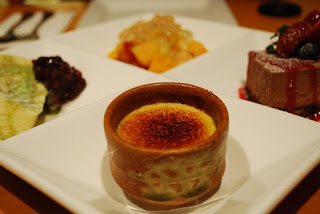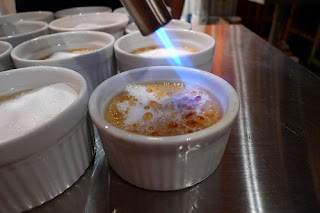from
Behind the French Menu
by
Bryan G. Newman
behindthefrenchmenu@gmail.com
Crème Brulée.
www.flickr.com/photos/avlxyz/3899678949/
Alain Sailhac and the modern Crème Brulée,
There are many stories about the creation of Crème
Brulée, both modern and from the Middle Ages. However, without too many
arguments, the modern Crème Brulée was created and launched, or at least was
recreated and relaunched in 1982 by the French-born, and, French-trained chef
Alain Sailhac. The launch took place at
Le Cirque, which at the time was the most famous French restaurant in the USA,
and Alain Sailhac was the executive chef (1978 – 1986). With so much French input French chefs in
France were able to accept Crème Brulée as a genuinely French creation.
Crème
Brulée with fruit
Alain Sailhac created Crème Brulée by producing a
lighter version of the traditionally richer, and thicker crusted, Spanish
dessert called Crema Catalana. The custard that he made for the original dish
was egg yolks and heavy cream flavored with vanilla
while the thicker Crema Catalana custard was flavored with cinnamon
and lemon.
Kitchen
flame - the blowtorch at work.
The crispy caramelized topping on crème brulée is
achieved with the aid of a specialized kitchen blowtorch. Unfortunately, you
cannot duplicate the topping under a regular home grill. You need a strong
flame applied for a short time on a targeted area and today that is best
supplied with a kitchen blowtorch; The crispy caramel topping defines a good
crème brulée. If I am offered a crème
brulée, and the caramelized topping is perfect, then I mostly consider the rest
an afterthought; however, I have been told that my view is in the minority.
Unconventional
crème brulées
www.flickr.com/photos/tekkbabe859/34482972391/
Crème Brulée on French menus:
Crème
Brulée à la Bergamote - Crème Brulée flavored with the bergamot orange; this
is the same orange used to flavor Earl Grey tea.
Crème Brulée à la Vanille et au Pain d'Épices – Crème Brulée flavored with vanilla on a gingerbread base.
Crème Brulée and wild strawberries.
www.flickr.com/photos/billsophoto/4658163800/
Crème
Brûlée au Dulce de Léché - Crème Brulée made with Dulce de léché so loved by
Argentinians’ and others. Dulce de léché is made by slowly heating
and caramelizing sweetened milk.
Crème
Brulée au Miel de Sapin des Vosges AOC/AOP - Creme
brulee made with the unique honey made from honeydew that bees collect from the aphids on the fir trees in
the Vosges in the Lorraine. This is a special honey with a
slightly malty flavor and it carries that valuable AOP/AOC, the French and European label of uniqueness and quality.
Crème Brulée au Parmesan et Tomates Séchées – Crème Brulée made with dried
tomatoes and Parmesan cheese; a savory Crème Brulée.
Crème Brulée et Fève de Tonka - Crème Brulée flavored with the
Tonka bean. The Tonka bean's origins are South
American, and when included in a cooked dish, its aroma contains the scents of vanilla, almonds, and cinnamon. The Tonka bean is said to be one
of the secret ingredients in the French alcoholic drink Pernod. The anise and aniseed flavored Pernod took
over from Absinthe when it was banned in France in
1915.
BTW -
Selling Tonka Beans or adding Tonka beans to processed foods has been illegal
in the US since 1954. Apparently, too
much Tonka and you will be very sick; nevertheless, I have never seen or heard
of any Tonka Bean problems in France or Canada.
Drink your Crème Brulee in the pub
Crème Brûlée
à la Vanille Bourbon - Crème Brulée with the original vanilla
flavoring used when Alain Sailhac created the modern Crème
Brulée.
The menu
listing above notes Vanille Bourbon and that
may make you think that you are going to receive a unique vanilla. However, Bourbon
vanilla, with its excellent flavor, is also the most common vanilla on the
market! (Some restaurants think that by
using a somewhat unknown, but interesting name, the product may sell better). Mexico was the source for all the three
popular types of vanilla seen today, and when botanists succeeded in growing
vanilla outside Mexico, the vanilla variety called Bourbon vanilla was grown on
France's Indian Ocean island of Réunion.
Until
the French revolution, the island of Réunion was called Île Bourbon, the
Bourbon Island; it had been named after France's Bourbon Kings. With the French
revolution, the revolutionaries changed the name of the island from that of
their hated Bourbon King to Réunion. Then, since 1946 Réunion is a
department/region of France and as much a part of France as Paris or Provence. If
you visit Réunion remember that while you are in the Indian Ocean you are also
in France and it is part of the European common market. In Réunion, you will
need Euros to pay your restaurant bills
and expect baguettes and croissants and a French breakfast.
Crème Brulée is more than just a
dessert.
Since Alain Sailhac’s original launch, the flavor and
the custard under the topping have seen many changes and the savory versions of
Crème Brulée are served as entrées, the French starters, or as garnishes
for the main course. At the same time, Crème Brulée remains one of the most
popular menu listings for dessert.
Crème Brulée
www.flickr.com/photos/k9d/8291788531/
The origins of Crème Brulee
Alain Sailhac linked the origins of the modern Crème
Brulee to the Catalan dish Crema Catalana.
However, Trinity College, Cambridge claims to be the primogenitor of the
contemporary Crème Brulée; they have
served a dish called Burnt Cream or Trinity Cream at the college since the
1800s’.
Veronica Shine
Then, I heard from Veronica Shine, who has a very
interesting blog on the Hispanic Kitchen.
Veronica Shine wrote that according to the
Confectionery Guild of Barcelona, the origins of Crema Catalana came from the
Jewish inhabitants of Catalonia. They used the flavors of the Moorish influence
in Spain, flavors from before 1492 with cinnamon and lemon two favorites. The
characteristics of today’s traditional Crema Catalana remains cinnamon and
lemon. Crema Catalana in the meantime has been declared a national dish and is
to be served, every year, on March 19th, St. Joseph’s Day (the Spanish
equivalent of Father’s Day).
Creme
Catalana
www.flickr.com/photos/55935853@N00/3661317180/
Veronica Shine's writings and others also pointed me in
the direction of the famous French chef Francois Massialot (1660- 1733). Massialot served several Royal French
households, and he wrote what would become a three-volume cookbook written
between 1691 and 1733. His book was
called Cuisinier Roïal et Bourgeois, The Chef, Both Royal and
Bourgeois.
Francois Massialot (1660 - 1733).
Massialot's
books were translated into English with part published in 1702 as The Court and
Country Cook. I have not read the
English translation, but I am told it has the exact recipe for the dish called
burnt cream in English; an English translation of Massialot's Crème Brulée and or Crème
Croquante - Crunchy Cream.
To see Francois Massialot’s book go on-line to the
French National Library website: the BnF, the Biblotech National de France click on the words Cuisinier Roïal et Bourgeois below:
The New Chef, Both Royal and
Bourgeois.
Printed MDCCV that’s 1705.
Francois
Massialot
You may read a copy of the original
book, in French on the French National Library website, without payment or
download the complete books for a small contribution. Follow the instructions in French, English, Spanish, or
German.
Massialot’s original recipe for Crème
Brulée a l’Orange
with a pistachio accent
For the original recipe for Crème Brulée a l’Orange –
Orange accented Crème Brulée read
page 281 and for the recipe for Crème Croquante - Crunchy Cream read
page 282.
Meanwhile, Alain
Sailhac, back in the USA
Alain Sailhac, the creator of the modern Crème Brulée,
changed careers in 1986 and became the
Executive Vice President and Dean Emeritus at the ICA, the International
Culinary Center, USA. (Originally this school was the French Culinary
Institute). In1997 Alain Sailhac was named chef of the year by the Maîtres
Cuisiniers de France, the Master Chefs of France.
Michael Lomonaco, Andre Soltner, Alain Sailhac
www.flickr.com/photos/internationalculinarycenter/5740526131/
-----------------------------------
Behind the French Menu
by
Bryan G. Newman
behindthefrenchmenu@gmail.com
Copyright 2010, 2012, 2014, 2019.
---------------------------
Searching for the meaning of words,
names or phrases
on
French menus?
Just add the word, words, or phrase that you are
searching for to the words "Behind the French Menu" (best when
including the inverted commas), and search with Google or Bing, Behind the French Menu’s links, include
hundreds of words, names, and phrases that are seen on French menus. There are
over 450 articles that include over 4,000 French dishes with English
translations and explanations.
----------------------------
Connected Posts:










No comments:
Post a Comment